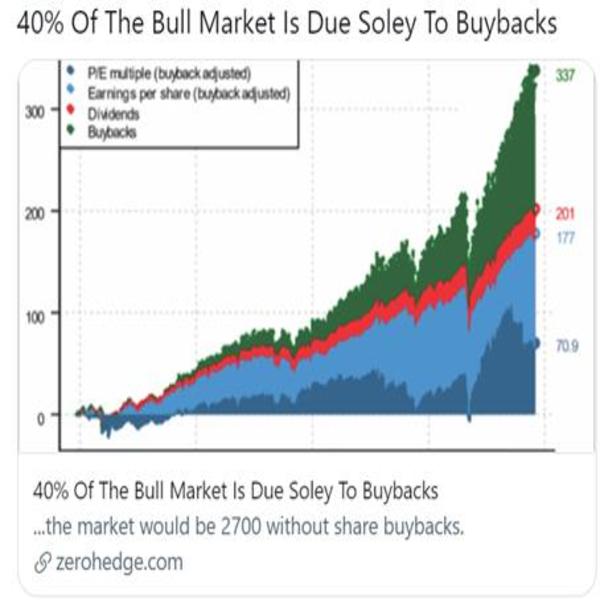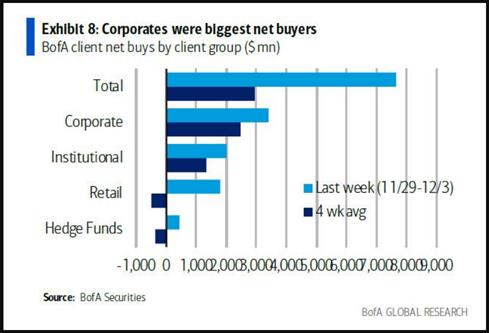You might recall our article from last weekend regarding “painting the tape” where we alluded to the Fed (Plunge Protection Team) coming into the market late that week on Friday and buying stocks to “prop” up the market.
While we are certain this occurred, we now learn from Bank of America (NYSE:BAC) and Goldman Sachs (NYSE:GS) that corporations saw the brief and significant pullback as an opportunity to buy back their own stock.

In essence, it is another group of artists adding to the stunning upside picture this year. For those not familiar with this concept, there are several reasons corporations buy back stock:
- Publicly traded Corporations buy back shares held by the public and retire those shares into their own treasury. This reduces the number of shares in circulation and increases the amount of earnings per available share, tending to make the shares worth more.
- Corporations are sitting on huge piles of cash and need to deploy it or there will be shareholder revolt to increase (or institute) a dividend or special distribution to shareholders.
- Corporations feel that their business growth, potential stock price appreciation and lack of other investment opportunities warrants prioritizing making investments in their own stock.
- The thesis for these Corporations is that if they reduce the outstanding stock held by others, including major institutions, the potential appreciation in their stock (future ROI) is a far better use of their money than cash sitting in their coffers.
- They have already received the Board’s approval to repurchase the stock (and reduce the outstanding shares) and are just waiting for what they deem an appropriate window to execute the repurchases.
We now have learned that the week of Nov. 29 and especially Friday Dec. 3, late afternoon, was just such opportunity. Moreover, given the seasonality and typical inflows of capital from bonuses, year-end partnership distributions, and the possibility of a year-end “Santa Claus” rally, it seemed to be a good time to put these repurchases into action.
Bank of America reported a surge of $6.7 billion in repurchases came in during this recent pullback, exceeding all estimates from the firms that track repurchases. They also point out that 40% of the net buying of equities is due solely to repurchases this year.
The NASDAQ is up around 23% this year and fully 64% of that return is due solely to 5 stocks: Microsoft (NASDAQ:MSFT), Google (NASDAQ:GOOGL), NVIDIA (NASDAQ:NVDA), Apple (NASDAQ:AAPL), and Tesla (NASDAQ:TSLA). At least 3 of these firms are the largest corporations repurchasing their shares this year.
The chart below shows how big this share repurchasing has been throughout 2021:

Risk On/Bullish
- Risk Gauges improved to mostly Risk-On, except for iShares Russell 2000 ETF (NYSE:IWM) which is still Neutral
- As we pointed out last week, the key market indices bounced off short-term oversold levels
- Sentiment shows that the number of underlying stocks within SPDR® S&P 500 (NYSE:SPY) that are above their 10-day moving average is getting frothy, a sharp correction from recent oversold readings
- Short-term Volatility via iPath® Series B S&P 500® VIX Short-Term Futures™ ETN (NYSE:VXX) has given up its recent gains and is showing Risk-On for the short-term
- Although every key market sector that we watch was positive on the week, Technology Select Sector SPDR® Fund (NYSE:XLK) and SPDR® S&P Homebuilders ETF (NYSE:XHB) led the week, a risk-on indication
- The majority of the sectors—except for Financial Select Sector SPDR® Fund (NYSE:XLF) and SPDR® S&P Retail ETF (NYSE:XRT)—are now back in a bullish phases
Neutral Metrics
- Volume patterns improved to neutral, an improvement from the distribution we saw last week
- Market internals for SPY have improved, but there is still a disparity between the McClellan Oscillator showing a negative number despite price improving drastically (thin market)
- On a 30-day basis, IWM is still down -8% while the other industries are up about 1% on average over the same span. IWM is currently in a distribution phase
- The theme of Value, via Vanguard Value Index Fund ETF Shares (NYSE:VTV) vs. Growth, via Vanguard Growth Index Fund ETF Shares (NYSE:VUG), remains indecisive short-term, with the longer-term trend still intact favoring Growth
- Foreign equities continue to lag US equities
- Gold via {{9227|SPDR® Gold Shares (NYSE:GLD) has been underperforming the SPY on a relative basis the entire year, but looks like it will continue to trade in a range near its key moving averages moving into the week, watch for a break above the 50 and 200-day moving averages
- iShares 20+ Year Treasury Bond ETF (NASDAQ:TLT) were overbought last week and subsequently mean-reverted to the downside this week, now trading within its 8-month trading range
- Cash Volatility (VIX.X) is still maintaining support at its 200-day moving average for the time being
Risk Off/Bearish
- Within Mish’s Modern Family, Retail (XRT) is the laggard, and is still down -3.5% over the past 6-months
- Soft Commodities—Invesco DB Agriculture Fund (NYSE:DBA)—weakened on a relative basis, but on an absolute price basis held its breakout and remains in a bull phase
- The Chinese yuan, via WisdomTree Chinese Yuan Strategy Fund (NYSE:CYB), got smashed last week, down more than -6%, adding fuel to the rally in US equities
- The Hindenburg indicator is still showing 17 omens
Crypto
- Despite being down on the week, Bitcoin (BTC) is still maintaining support at its 200-day moving average and is trading above $48,000, (at time of writing) even seeing a bit of a bounce into the weekend
- The ETH/BTC ratio topped out at 3-year highs this past week and now looks to be rolling over, indicating the possibility that Bitcoin may begin outperforming Ethereum on a relative basis very soon
- Polygon (MATIC) led all large cap cryptos this past week +5%, reaching its highest levels since May
- US regulatory discussions regarding the cryptocurrency industry saw favorable attention this week, as well as in other major countries like India where regulations are turning out to be far looser than many were anticipating
